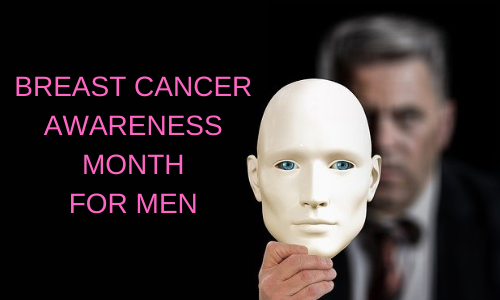 FACTS FOR THE MEN IN OUR LIVES
FACTS FOR THE MEN IN OUR LIVES
It’s WELLNESS WEDNESDAY everyone and time for another Blog dedicated to BREAST CANCER AWARENESS MONTH.
Most of us are under the impression that breast cancer is a women’s disease. Yet even though it’s far less common, men can develop breast cancer as well. So, let’s shine a bright light on this subject as we devote this particular piece to the men in our lives and to their good health.
To begin, breast cancer remains a rare condition in men. In the United States, for example, approximately fifteen hundred men are diagnosed with the disease each year. By comparison, the number of women diagnosed with the disease each year in the United States is about one hundred times greater — or close to 150,000 cases annually. So, why the discrepancy? Why is there such a difference in the rates of this disease among men and women?
To answer this, we need to understand a bit about the structure and development of the human breast. Until puberty the female and male breasts remain basically the same when human hormones kick in, including estrogen in the female and testosterone in the male. Estrogen increases the growth of structures known as ducts, milk glands and fatty connective in the female. Testosterone suppresses the growth of these structures in the male.
Yet the male breast still contains a small amount of nonfunctioning breast tissue, which means tissue that cannot produce milk. This tissue is concentrated directly behind the nipple on the chest wall. And, it’s this tissue in both females and males that is susceptible to the uncontrolled growth of abnormal cells that may lead to breast cancer.
Not surprisingly, many of the breast cancer risks that affect women also affect men. And here are 4 of the most common.
RADIATION EXPOSURE
Men who have undergone radiation therapy for a condition affecting the chest area such as a malignancy resulting from Hodgkin’s lymphoma or a tumor of the lung have an increased risk for developing breast cancer.
ESTROGEN
An increase of estrogen in men can result in gynecomastia, which is an enlargement of the breasts. More breast tissue results in a higher risk for developing breast cancer. And there are three primary conditions associated with an increase in estrogen and breast enlargement in men.
Klinefelter’s Syndrome
Klinefelter’s syndrome is an inherited condition that affects about one in one thousand men. Men normally inherit an X chromosome from their mother and a Y chromosome from their father. Men with Klinefelter’s have inherited an extra X chromosome from their mother resulting in an abnormal chromosomal makeup of XXY instead of the normal XY. Due to the “extra X” chromosome, these men produce higher levels of estrogen, which results in breast enlargement and increases their risk for breast cancer.
Cirrhosis of the Liver
Cirrhosis of the liver can result from chronic viral hepatitis, alcohol abuse or a rare genetic condition. All, however, compromise liver function. And when this occurs, the levels of male and female hormones in the bloodstream are altered. Men with cirrhosis of the liver typically have higher blood levels of estrogen and, therefore, an increased risk for breast cancer.
Obesity
Obesity, of course, is associated with higher levels of estrogen in both males and females, which again increases one’s risk for breast cancer.
DRUG USE
The use of finasteride, also known as Propecia or Proscar, also can increase a man’s risk for breast cancer. Now this drug typically is used to treat hair loss, benign conditions of the prostate such as hyperplasia and to prevent prostate cancer. Unfortunately, its use to improve or prevent one condition may increase the risk for developing another — namely breast cancer.
HEREDITY
We all know that an anomaly of the BRCA 1 and 2 genes in women is associated with an increased risk for different cancers including that of the breast. We also know that women who have family members with breast cancer have a greater risk for developing the disease.
But did you know that men who have several female relatives with breast cancer also have an increased risk for developing breast cancer? Men with a family history of a BRCA2 gene anomaly also may have a greater risk for developing breast cancer. Moreover, if this anomaly exists, the risk for developing prostate cancer is greater as well.
In addition to these facts, it’s important to seek medical advice if any of the following should occur:
- A lump or bump in the breast tissue
- A change in the shape of the nipple
- Discoloration, redness or scaling of the breast tissue
- Any discharge from the nipple
All of us, men and women, are in the fight against BREAST CANCER together. Being informed, staying proactive and exercising common sense will go a long way in protecting each other and all the men and women in our lives.
Thanks again for joining me everyone. Until next time, please remain safe, stay in GOOD HEALTH, and . . .
TAKE THE COURSE AND TAKE CHARGE!



Leave a Comment